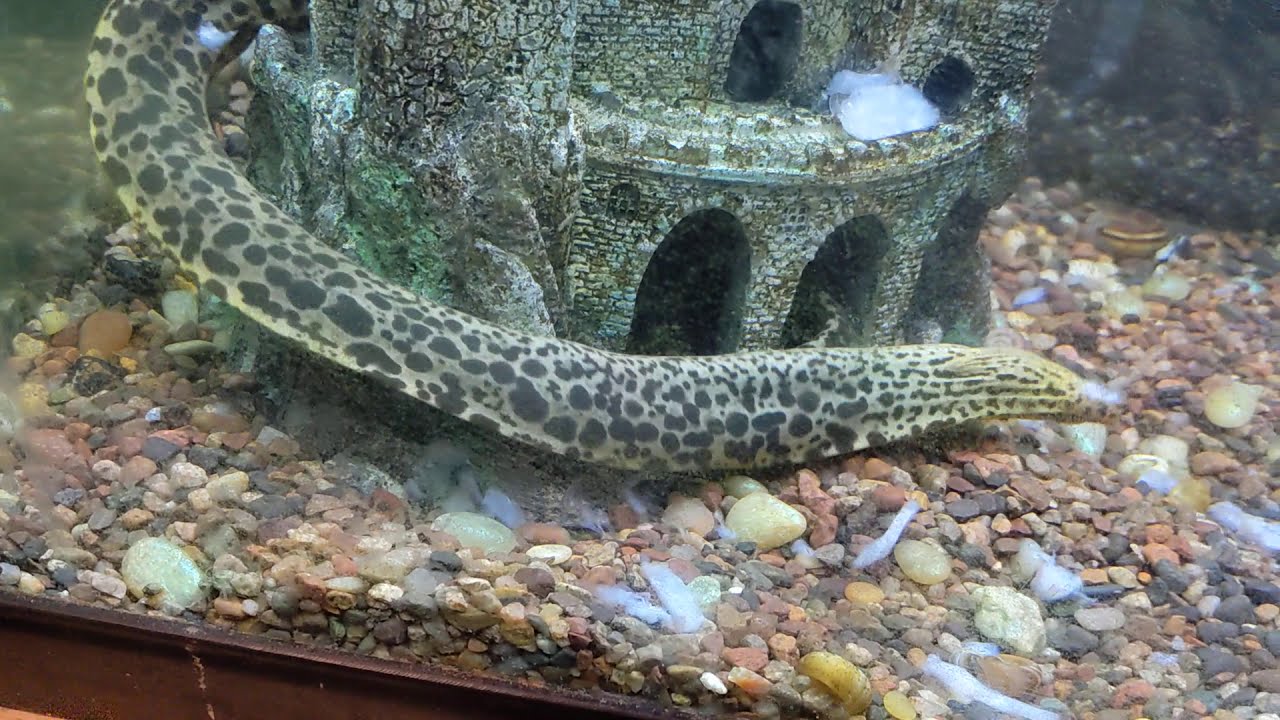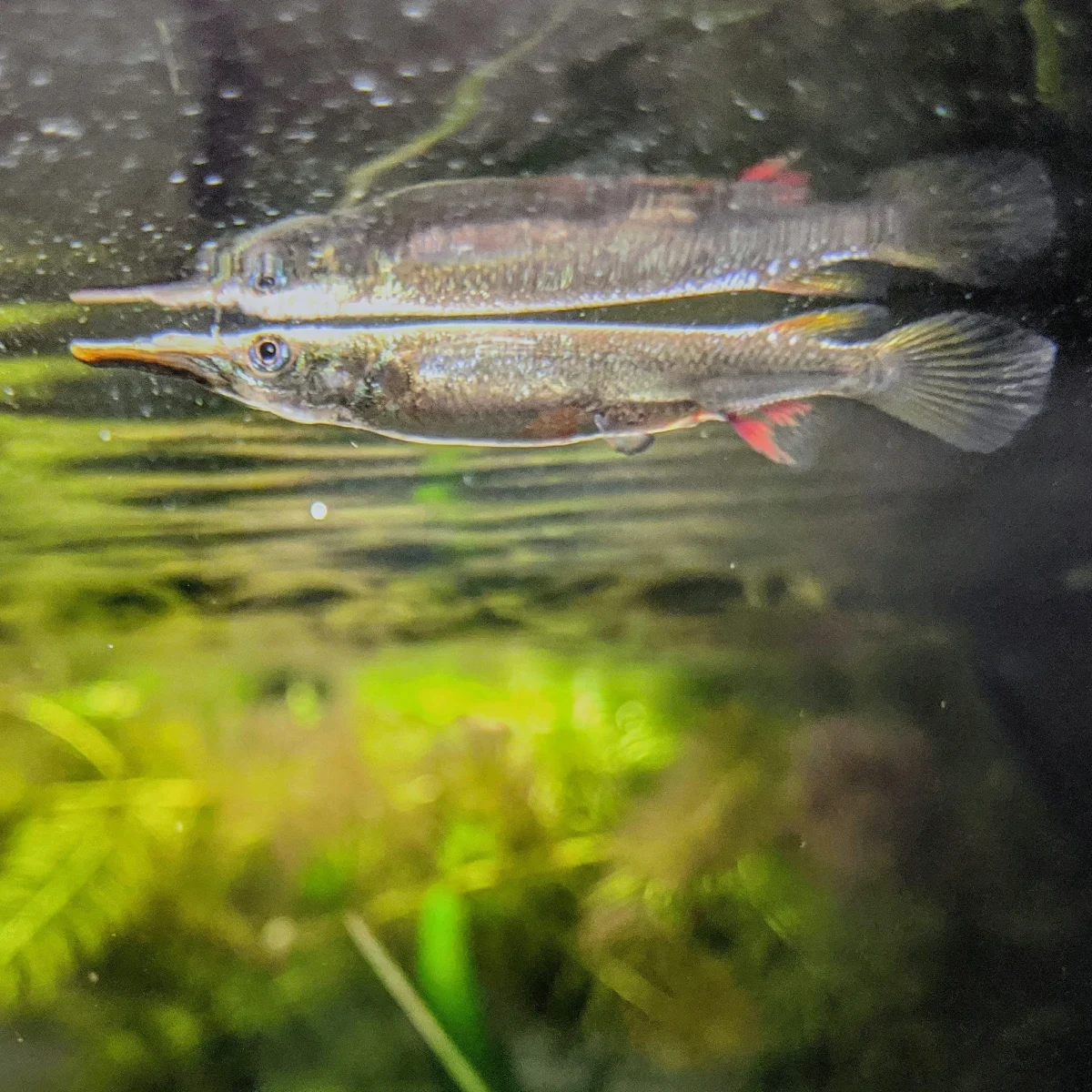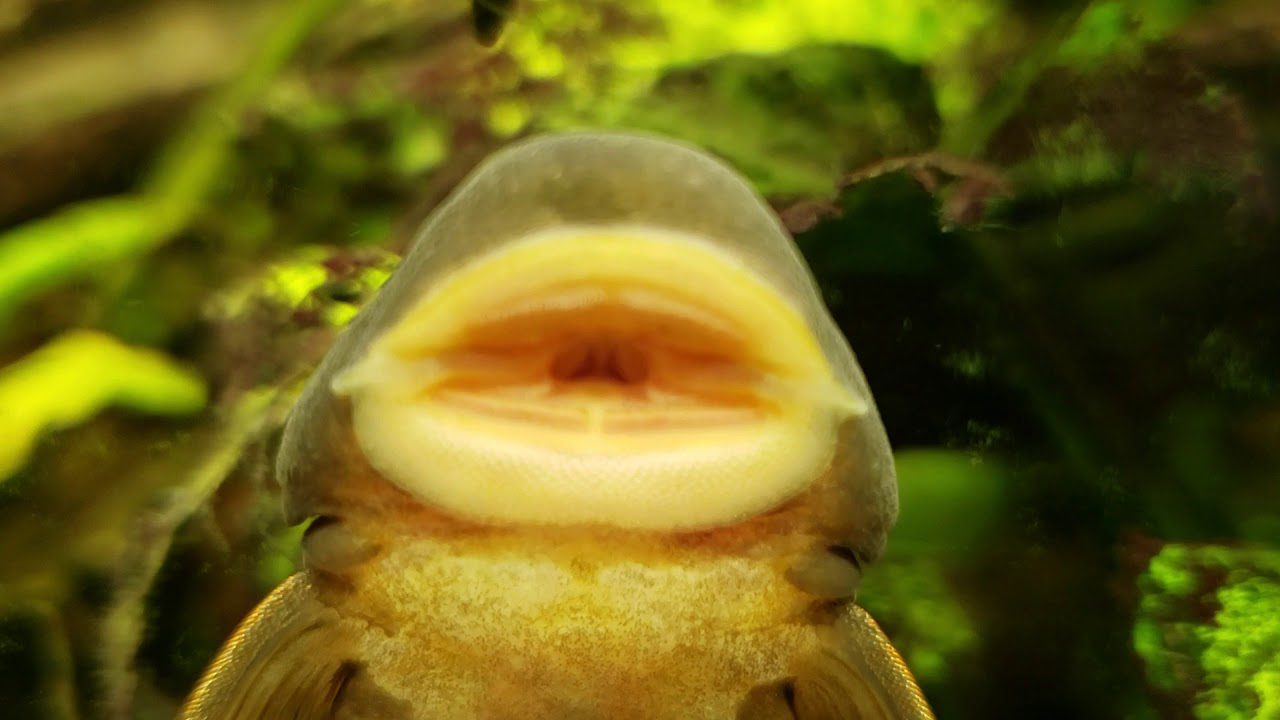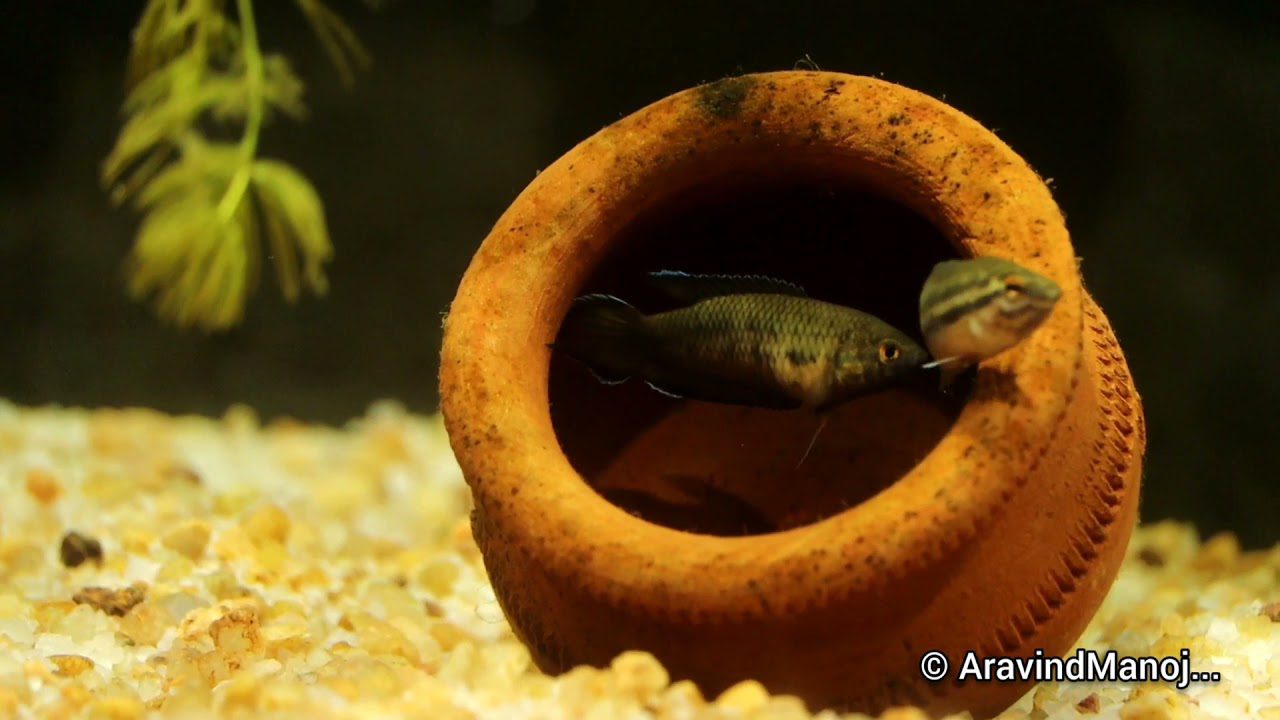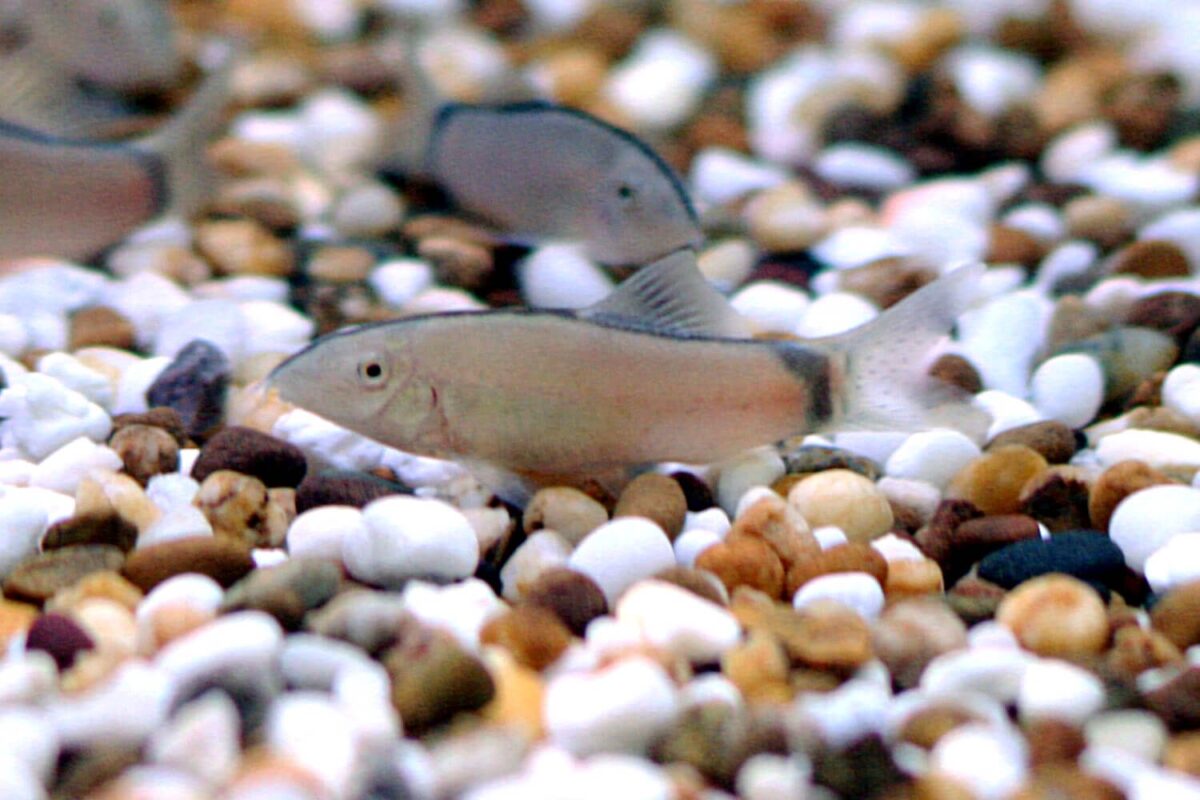The Freshwater Moray, also known as Gymnothorax polyuranodon, is a captivating eel species commonly found in tropical fish stores and pet shops. Despite its name, the Freshwater Moray thrives best in brackish water, not freshwater. Maintaining the proper conditions in the tank for the eel is vital to ensure its health and longevity. The Freshwater Moray requires a tank with hiding spots, such as caves or large rocks, as they are nocturnal and enjoy dim or dark areas. Holes and openings in the tank should be covered to prevent the eel from jumping out. It is worth noting that the Freshwater Moray can deliver a painful bite if it feels threatened, so caution should be exercised when handling or interacting with the eel. With the proper care and environment, the Freshwater Moray can live for many years and become a beloved pet fish.
Key Takeaways:
- Freshwater Moray, or Gymnothorax polyuranodon, is a popular eel species for aquariums.
- Despite its name, the Freshwater Moray thrives in brackish water habitats.
- The eel requires a tank with hiding spots and dim or dark areas.
- Caution should be exercised when handling the Freshwater Moray, as it can deliver a painful bite.
- The Freshwater Moray can live as a pet fish with proper care and environment for many years.
Introduction
Welcome to Section 2 of our article on the Freshwater Moray, Gymnothorax polyuranodon. In this section, we will explore the taxonomy and classification of this fascinating eel species and its natural habitat and distribution.
Taxonomy and Classification
The Freshwater Moray, scientifically known as Gymnothorax polyuranodon, belongs to the family Muraenidae. Taxonomically, it is classified under the species Gymnothorax polyuranodon.
Natural Habitat and Distribution
The Freshwater Moray is predominantly found in brackish water habitats, particularly in coastal mangrove swamps and tropical estuaries. Its natural distribution includes the East Indian Sundarbans mangrove swamps, Indonesia, the Philippines, the Andaman Islands, New Guinea, Palau, Australia, and the Fiji Islands.
Although the name suggests a preference for freshwater, the Freshwater Moray is primarily a saltwater species. However, it can temporarily enter freshwater environments for specific activities such as feeding, removing saltwater parasites, and spawning. To ensure the well-being of the Freshwater Moray in an aquarium, it is crucial to recreate its natural habitat as closely as possible.
Physical Description and Characteristics
The Freshwater Moray is a captivating species of eel known for its unique appearance and behaviour. This eel has a long, slender body and a pointed snout, giving it an intimidating look. The typical colouration of the Freshwater Moray is grey, with golden-yellow dots scattered along its lateral and dorsal sides. As the eel ages, these dots become smaller, resulting in a more solid-gray appearance.
Colours and Markings
The Freshwater Moray exhibits a distinct colouration pattern, with its grey body and golden yellow dots. These dots give the eel a stunning and eye-catching appearance. Over time, these dots change in size, but they remain a defining characteristic of the Freshwater Moray’s colouration.
Gender Differences
Visual distinctions between male and female Freshwater Morays are not prominent. Determining the sex of an individual eel based on physical characteristics alone can be challenging. Additional methods, such as genetic testing, may be required to determine the gender accurately.
Varieties
The Freshwater Moray has different varieties, each slightly varying in colouration and markings. Some popular varieties include the Indian mud moray, gold dust moray, snowflake eel, and more. These variations add diversity and intrigue to the appearance of the Freshwater Moray species.
Grades
Grading for the Freshwater Moray is not commonly applied. Unlike certain fish species graded based on colouration or pattern, the Freshwater Moray is primarily appreciated for its natural appearance and behaviour.
Behaviour and Temperament
The Freshwater Moray is curious, often exploring its surroundings and investigating hiding spots. The nocturnal species prefers dim or dark areas in the tank, emulating its natural habitat. While generally shy, the Freshwater Moray can become stressed if not provided with the right environment, leading to a decline in its overall health and well-being.
Aquarium Requirements
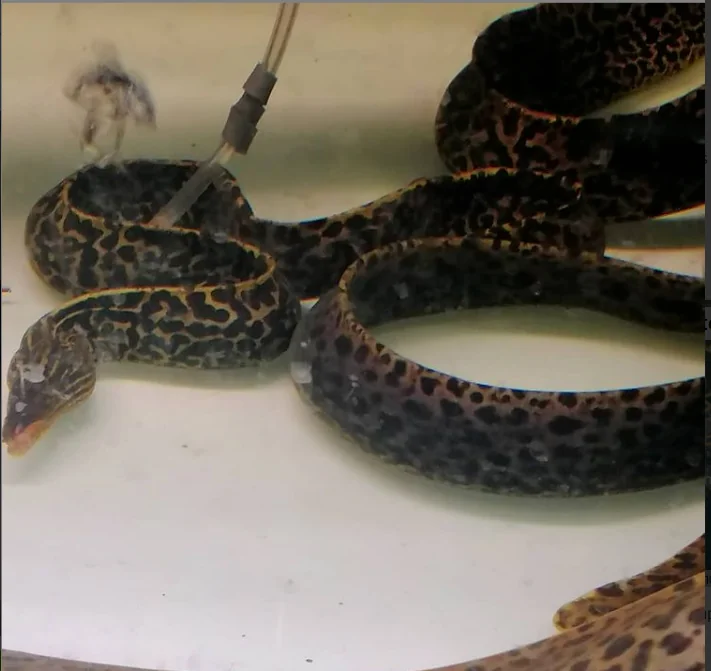
Providing the Freshwater Moray with the right aquarium setup is crucial for its health and longevity. This section will cover the ideal tank size and layout, water parameters, suitable tank mates, potential conflicts, and compatibility with live plants and invertebrates.
Ideal Tank Size and Layout
The ideal tank size for a Freshwater Moray is at least 30 gallons for a single adult. However, larger tanks are recommended for multiple individuals to ensure sufficient space for each eel. The tank should be spacious enough to allow the eel to move freely and provide hiding spots such as caves, rocks, and dense vegetation to mimic their natural habitat.
Water Parameters
Maintaining proper water parameters is essential for the health of the Freshwater Moray. The temperature should be between 75-82°F (24-28°C), with a pH of 7-8.5. Since the eel thrives in brackish water, a salinity level of 1.005-1.010 is recommended. Additionally, monitoring and maintaining appropriate water hardness is essential for the eel’s well-being.
Suitable Tank Mates and Potential Conflicts
When choosing tank mates for the Freshwater Moray, it is essential to consider their size and temperament. Suitable tank mates include larger fish species such as dats, scats, monos, puffers, and other eel species. However, caution should be exercised when introducing tank mates, as the Freshwater Moray can be territorial and may display aggression towards smaller fish or those with a similar body shape.
Compatibility with Live Plants and Invertebrates
The Freshwater Moray’s compatibility with live plants and invertebrates may vary. Some individuals may uproot plants or feed on small invertebrates, while others may coexist peacefully. Choosing hardy plant species and larger invertebrates that can withstand the eel’s presence and potential interactions is recommended. Regular monitoring should ensure the plants and invertebrates remain healthy in the eel’s environment.
Freshwater Moray Eel – Care
Proper care is essential for the health and well-being of the Freshwater Moray. Regular maintenance of the tank is crucial to prevent water quality issues. This includes performing regular water changes, keeping the filtration system clean, and monitoring water parameters. Maintaining appropriate temperature, pH level, salinity, and water hardness will help create optimal conditions for the eel.

A critical aspect of care is monitoring the Freshwater Moray for signs of illness. The eel can be susceptible to bacterial, fungal, and parasitic infections. Observing the eel’s behaviour, appetite, and physical appearance is essential for any changes that may indicate illness. Prompt identification and treatment of diseases are crucial for the eel’s recovery and overall health.
Remember to exercise caution when handling or interacting with the eel, as it can deliver a painful bite if threatened. Following proper care guidelines and providing a suitable environment will ensure a healthy and thriving freshwater moray in your aquarium.
Diet and Feeding
Proper diet is essential for the Freshwater Moray’s overall health and vitality. The eel has specific dietary preferences and should be offered a varied and balanced diet to ensure optimal nutrition.
Dietary Preferences
The Freshwater Moray has a carnivorous diet that primarily feeds on small seafood such as live or frozen bloodworms, shrimp, and squid. These protein-rich foods mimic their natural diet and provide essential nutrients for their growth and development.
Recommended Foods and Feeding Schedule
To meet the nutritional needs of the Freshwater Moray, it is recommended that a variety of foods be offered. This can include live or frozen bloodworms, small pieces of shrimp or squid, and other similar small seafood. Feeding should be done using tweezers or tongs to prevent accidental bites.
A feeding schedule of 2-3 times per week is sufficient for adult Freshwater Morays. It is vital to monitor their appetite and adjust the feeding schedule accordingly. Overfeeding should be avoided, as it can lead to obesity and other health issues.
Tips on Ensuring a Balanced and Nutritious Diet
To ensure a balanced and nutritious diet for the Freshwater Moray, it is crucial to consider the following tips:
- Offer a variety of protein sources to provide a diverse range of nutrients.
- Occasionally, they supplement their diet with vitamins and minerals to ensure they receive all the necessary nutrients.
- Monitor the eel’s overall health and body condition to ensure they are receiving adequate nutrition.
- Consult with a knowledgeable fishkeeper or veterinarian for advice on specific dietary requirements for the Freshwater Moray.
- Observe any changes in appetite or feeding behaviour, as it may indicate underlying health issues.
By following these tips and providing a balanced and nutritious diet, you can help ensure the overall health and well-being of your Freshwater Moray.
Breeding and Reproduction
Breeding the Freshwater Moray in captivity can be challenging and requires specific conditions and knowledge. Sexing the Freshwater Moray can be difficult based on visual characteristics alone, as males and females have no distinct external differences.
Sexing
Determining the sex of the Freshwater Moray can be challenging due to the lack of visible differences between males and females. Unlike some fish species, there are no significant variations in colouration or physical characteristics that can be used to accurately determine the sex of the eel.
Breeding Behavior and Conditions
The breeding behaviour of the Freshwater Moray involves courtship displays, nest preparation, and the subsequent release of eggs by the female. To induce breeding behaviour, it is essential to maintain proper water parameters, temperature, and hormonal stimulation in the tank.
Care of Eggs and Fry
Once the female Freshwater Moray lays eggs, it is crucial to monitor and protect them from potential predators carefully. The eggs should be transferred to a separate tank or breeding setup where they can be provided with appropriate water conditions, such as suitable temperature and water flow. The eggs and subsequent fry should be supplied with a nutritious diet and protected until they are strong enough to survive independently.
Challenges in Breeding in Captivity
Breeding the Freshwater Moray can be challenging due to the specialized needs and specific environmental conditions required for successful reproduction. Factors such as maintaining the correct water parameters, simulating natural breeding behaviours, and protecting the eggs and fry from potential threats can present obstacles in the breeding process.
Summary
The Freshwater Moray, Gymnothorax polyuranodon, is a captivating aquarium species known for its unique appearance and behaviour. Despite its name, the eel thrives best in brackish water and requires specific tank conditions to ensure its health and well-being.
Careful attention should be given to the eel’s diet, feeding schedule, water parameters, and tank mates to maintain optimal conditions. Providing a varied and balanced diet, maintaining proper water quality, and choosing suitable tank mates are essential aspects of caring for the Freshwater Moray.
While breeding the Freshwater Moray in captivity can be challenging due to their specialized needs, it can also be rewarding for experienced aquarium enthusiasts. It requires knowledge of their courtship behaviours, creating appropriate breeding conditions, and providing suitable care for the eggs and fry.
With proper care and attention to detail, the Freshwater Moray can thrive and become a stunning addition to any aquarium. By replicating their natural habitat, providing nutritious food, and creating a safe and comfortable environment, enthusiasts can enjoy the company of this unique and fascinating eel species for years to come.

